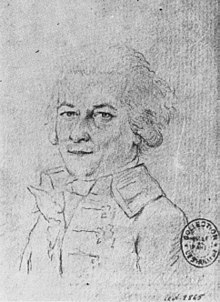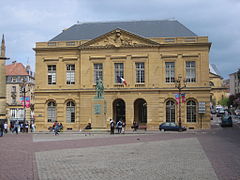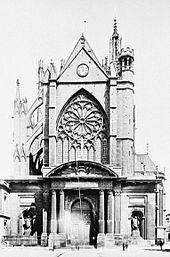| Jacques-François Blondel | |
|---|---|
 Blondel in a c. 1760 illustration Blondel in a c. 1760 illustration | |
| Born | 8 January 1705 Rouen, France |
| Died | 9 January 1774(1774-01-09) (aged 69) Louvre Palace, Paris, France |
| Occupation | Architect |
| Spouses |
|
| Practice | Neoclassicism |
Jacques-François Blondel (8 January 1705 – 9 January 1774) was an 18th-century French architect and teacher. After running his own highly successful school of architecture for many years, he was appointed Professor of Architecture at the Académie Royale d'Architecture in 1762, and his Cours d'architecture ("Course of Architecture", 1771–1777) largely superseded a similarly titled book published in 1675 by his famous namesake, François Blondel, who had occupied the same post in the late 17th century.
Career

Born in Rouen, he initially trained under his uncle Jean-François Blondel (1683–1756), architect of Rouen. Jacques-François was in Paris by 1726 and continued his studies with Gilles-Marie Oppenord, from whom he acquired a knowledge of rococo. He also worked with Jean Mariette, contributing to the latter's L'Architecture françoise (1727, 1738), as a writer and as an architectural engraver. Blondel developed into a conservative and thorough architect, whose rationally ordered mind consolidated French classical tradition and practice.
His first independent publication was the hugely influential encyclopedic work, De la Distribution des Maisons de Plaisance, et de la Décoration des Edifices en General, issued at Paris, 1737–38. It contained 155 carefully engraved plates. His Distribution des Maisons de Plaisance and other engraved work attracted a commission to produce thirteen of the engravings for the festival book commemorating the fêtes that celebrated the wedding of Madame Elizabeth of France with Dom Philippe of Spain, published in 1740.
That same year he opened his own private school in Paris, the École des Arts, sanctioned by the Académie in 1743. In the ensuing years a long sequence of architects profited from his discourse: Boullée, Brongniart, Chalgrin, La Guêpière, Desprez, de Wailly, Gondoin, Ledoux, Guimard and Rondelet, and to foreigners who would bring Neoclassicism home with them: the Anglo-Swedish Sir William Chambers, and the Dane Caspar Frederik Harsdorff. "Blondel was the most significant French architectural educator of the eighteenth century.....his objective was to establish design principles for domestic architecture that correspond to the classical principles already in practice for civil structures".

In his clear and rational Architecture françoise, a four-volume work published from 1752 to 1756, he covered the past century and more of French buildings in and near Paris, setting them in their historical context and providing a wealth of detailed information that would otherwise have been lost. In the preface, he remarked, "I have used simple terms and a popular style with the intention of being understood by layman and artist alike; having noticed that recent books about architecture are either badly organised or overlong." He originally planned eight volumes, but only the first four were published. The work brought him to official notice; he was inducted into the Académie Royale d'Architecture in 1755 and appointed architect to Louis XV.
Though his executed body of work was small, mostly confined to work he executed at Metz under commission of the duc de Choiseul, his approach was soundly grounded: for Diderot's Encyclopédie he wrote the article on masonry, as well as architecture, and contributed nearly 500 articles between 1751 and his death in 1774.
In 1762, he was appointed Professor of Architecture at the Académie, closing his own school and introducing his comprehensive curriculum to the Académie. His Cours d'architecture ou traité de la décoration, distribution et constructions des bâtiments contenant les leçons données en 1750, et les années suivantes began appearing in 1771 and ran to nine volumes by 1777, a volume of plates to each two volumes of text; the last volumes were seen through the press by his disciple Pierre Patte. His Cours d'architecture is sometimes referred to as the "Petit Blondel" to distinguish it from the "Grand Blondel", his Architecture françoise. Blondel's practical, encyclopedic approach, largely ignoring the excesses of Rococo, had survived changes in taste and remained in the mainstream of French architectural training for several decades more.
Personal life
Blondel married Marie Anne Garnier in 1729. Their son, Georges-François Blondel, who was born in 1730, became an architectural engraver. They also had a daughter, Claudine Angelique. After his first wife's death in 1755, Jacques-François married Manon Balletti in 1760. Their son, Jean-Baptiste Blondel, who later became an architect for the city of Paris, was born in 1764. During his final illness, Jacques-François requested to be taken to his classrooms at the Louvre, where he died surrounded by his books, his architectural models, and his students.
References
Notes
- Arnold 1998.
- Colognola states that Jacques-François Blondel was the grandson of François Blondel. This is not supported by Arnold 1998, Tadgell 1998, Herrmann 1982, Harrington 1982, or Braham 1980, pp. 37–39.
- Sturges 1952, p. 16.
- Arnold 1998.
- Chisholm 1911.
- Harrington 1982, p. 220.
- Sturges 1952:16.
- Millard, 1993, p. 25
- Blondel, quoted in Sturges 1952:16.
- The intended contents of the eight volumes, including the four which remained unpublished, are summarised in the preface to vol. 1.
- One of a number; he was not Premier Architecte du Roi.
- His classical colonnades and entrance portal for the Cathedral of Metz were replaced by more acceptable Gothic pastiches in the later nineteenth century, but Blondel's entrance survived long enough to be photographed (illustrated in Sturges 1952:18 fig. 4).
- Frank A. Kafker: Notices sur les auteurs des dix-sept volumes de « discours » de l'Encyclopédie. Recherches sur Diderot et sur l'Encyclopédie (1989) Volume 7 Issue 7 p. 130–131
- Schwab 1984, p. 491.
- Benjamin Smith 1918, p. 1100; Edward Smith 1904, p. 239.
- Balletti is probably better known for her relationship with Casanova.
- Harrington 1982, p. 220.
- Harrington 1982, p. 223.
Sources
- Arnold, Dana (1998). "Blondel" in Turner 1998, vol. 4, pp. 162–165.
- Braham, Allan (1980). The Architecture of the French Enlightenment. Berkeley: University of California Press. ISBN 9780520067394.
- Chisholm, Hugh, ed. (1911). "Blondel, Jacques François" . Encyclopædia Britannica. Vol. 4 (11th ed.). Cambridge University Press. pp. 76–77.
- Colognola, Rita. "Jacques-François Blondel (and Pierre Patte)". Antiquariaat Papyrus. Retrieved January 3, 2012.
- Harrington, Kevin (1982). "Blondel, Jacques-François" in Placzek 1982, vol. 1, pp. 220–223.
- Hermann, Wolfgang (1982). "Blondel, François" in Placzek 1982, vol. 1, pp. 216–219.
- The Mark J. Millard Architectural Collection: French Books (National Gallery of Art) 1993. ISBN 0-8076-1281-2
- Placzek, Adolf K., editor (1982). Macmillan Encyclopedia of Architects. New York: Collier Macmillan Publishing. ISBN 9780029250006.
- Schwab, Richard N. (1984). Inventory of Diderot's Encyclopédie. VII. Inventory of the plates, with a study of the contributors to the Encyclopédie by John Lough. Oxford: The Voltaire Foundation at The Tayor Institution. ISBN 9780729403108.
- Smith, Benjamin Eli (1918). The Century Cyclopedia of Names. New York: The Century Co. View at Google Books.
- Smith, Edward R. (1904). "The Topographical Evolution of the City of Paris. IV. Royal Paris" in House & Garden, vol. 6 (July to December, 1904), pp. 227–239 (at Google Books).
- Sturges, W. Knight (1952). "Jacques-François Blondel" The Journal of the Society of Architectural Historians 11.1 (March 1952:16-19).
- Tadgell, Christopher (1998). "Blondel, (Nicolas-)François" in Turner 1998, vol. 4, pp. 165–166.
- Turner, Jane, editor (1998). The Dictionary of Art, reprinted with minor corrections, 34 volumes. New York: Grove. ISBN 9781884446009.
External links
- Blondel, Jacques-François (1737–1738). De la distribution des maisons de plaisance et de la décoration des edifices en général. Paris: Charles-Antoine Jombert. Vols. 1 and 2 at Gallica.
- Blondel, L'Architecture française: catalogue description of the reimpression of 1904
- Blondel, Jacques-François (1752–1756). Architecture françoise (in 4 volumes). Paris: Charles-Antoine Jombert. Online copies at Gallica.
- Vol. 1 (1752) Introduction à l'architecture, abrégé historique de la Ville de Paris, description des principaux édifices du Fauxbourg St. Germain
- Vol. 2 (1752) Description des principaux édifices du Quartier du Luxembourg, avec ceux de la Cité, du Quartier St. Antoine & du Marais
- Vol. 3 (1754) Description des principaux édifices des Quartiers Saint Denis, Montmartre, du Palais Royal & Saint Honoré
- Vol. 4 (1756) Description du Louvre & du Palais des Tuileries, celle du château, parc & jardins de Versailles
- Blondel's Cours d'architecture catalogued and described
- Blondel, Jacques-François (1771–1777). Cours d'architecture (in 6 volumes of text and 6 of plates; 5 & 6 by Pierre Patte). Paris: Desaint. Online copies at Gallica.
- Vol. 1: text (1771); plates
- Vol. 2: text (1771); plates (1771)
- Vol. 3: text (1772); plates (1773)
- Vol. 4: text (1773); plates (1773)
- Vol. 5: text (1777); plates (1777)
- Vol. 6: text (1777); plates (1777)
- 1705 births
- 1774 deaths
- 18th-century French architects
- Contributors to the Encyclopédie (1751–1772)
- French architecture writers
- Architectural theoreticians
- Architects from Rouen
- Members of the Académie royale d'architecture
- French male non-fiction writers
- French neoclassical architects
- 18th-century French male writers